Tanenbaum A. Computer Networks
Подождите немного. Документ загружается.


input. The right output is the bitwise XOR of the left input and a function of the right input and
the key for this stage,
K.
i
All the complexity lies in this function.
The function consists of four steps, carried out in sequence. First, a 48-bit number,
E, is
constructed by expanding the 32-bit
R
i
- 1
according to a fixed transposition and duplication
rule. Second,
E and K
i
are XORed together. This output is then partitioned into eight groups of
6 bits each, each of which is fed into a different S-box. Each of the 64 possible inputs to an S-
box is mapped onto a 4-bit output. Finally, these 8 x 4 bits are passed through a P-box.
In each of the 16 iterations, a different key is used. Before the algorithm starts, a 56-bit
transposition is applied to the key. Just before each iteration, the key is partitioned into two
28-bit units, each of which is rotated left by a number of bits dependent on the iteration
number.
K
i
is derived from this rotated key by applying yet another 56-bit transposition to it. A
different 48-bit subset of the 56 bits is extracted and permuted on each round.
A technique that is sometimes used to make DES stronger is called
whitening. It consists of
XORing a random 64-bit key with each plaintext block before feeding it into DES and then
XORing a second 64-bit key with the resulting ciphertext before transmitting it. Whitening can
easily be removed by running the reverse operations (if the receiver has the two whitening
keys). Since this technique effectively adds more bits to the key length, it makes exhaustive
search of the key space much more time consuming. Note that the same whitening key is used
for each block (i.e., there is only one whitening key).
DES has been enveloped in controversy since the day it was launched. It was based on a
cipher developed and patented by IBM, called Lucifer, except that IBM's cipher used a 128-bit
key instead of a 56-bit key. When the U.S. Federal Government wanted to standardize on one
cipher for unclassified use, it ''invited'' IBM to ''discuss'' the matter with NSA, the U.S.
Government's code-breaking arm, which is the world's largest employer of mathematicians and
cryptologists. NSA is so secret that an industry joke goes:
Q1: What does NSA stand for?
A1:
No Such Agency.
Actually, NSA stands for National Security Agency.
After these discussions took place, IBM reduced the key from 128 bits to 56 bits and decided
to keep secret the process by which DES was designed. Many people suspected that the key
length was reduced to make sure that NSA could just break DES, but no organization with a
smaller budget could. The point of the secret design was supposedly to hide a back door that
could make it even easier for NSA to break DES. When an NSA employee discreetly told IEEE
to cancel a planned conference on cryptography, that did not make people any more
comfortable. NSA denied everything.
In 1977, two Stanford cryptography researchers, Diffie and Hellman (1977), designed a
machine to break DES and estimated that it could be built for 20 million dollars. Given a small
piece of plaintext and matched ciphertext, this machine could find the key by exhaustive
search of the 2
56
-entry key space in under 1 day. Nowadays, such a machine would cost well
under 1 million dollars.
Triple DES
571
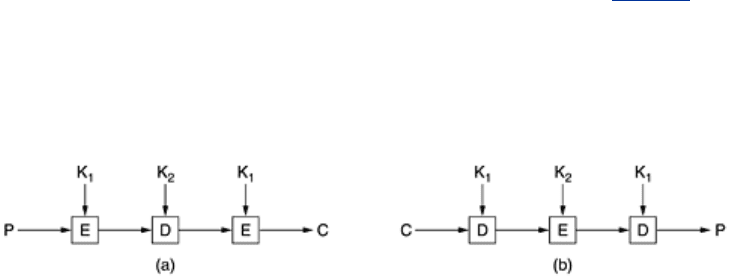
As early as 1979, IBM realized that the DES key length was too short and devised a way to
effectively increase it, using triple encryption (Tuchman, 1979). The method chosen, which has
since been incorporated in International Standard 8732, is illustrated in
Fig. 8-8. Here two
keys and three stages are used. In the first stage, the plaintext is encrypted using DES in the
usual way with
K
1
. In the second stage, DES is run in decryption mode, using K
2
as the key.
Finally, another DES encryption is done with
K
1
.
Figure 8-8. (a) Triple encryption using DES. (b) Decryption.
This design immediately gives rise to two questions. First, why are only two keys used, instead
of three? Second, why is
EDE (Encrypt Decrypt Encrypt) used, instead of EEE (Encrypt
Encrypt Encrypt
)? The reason that two keys are used is that even the most paranoid
cryptographers believe that 112 bits is adequate for routine commercial applications for the
time being. (And among cryptographers, paranoia is considered a feature, not a bug.) Going to
168 bits would just add the unnecessary overhead of managing and transporting another key
for little real gain.
The reason for encrypting, decrypting, and then encrypting again is backward compatibility
with existing single-key DES systems. Both the encryption and decryption functions are
mappings between sets of 64-bit numbers. From a cryptographic point of view, the two
mappings are equally strong. By using EDE, however, instead of EEE, a computer using triple
encryption can speak to one using single encryption by just setting
K
1
= K
2
. This property
allows triple encryption to be phased in gradually, something of no concern to academic
cryptographers, but of considerable importance to IBM and its customers.
8.2.2 AES—The Advanced Encryption Standard
As DES began approaching the end of its useful life, even with triple DES, NIST (National
Institute of Standards and Technology
), the agency of the U.S. Dept. of Commerce
charged with approving standards for the U.S. Federal Government, decided that the
government needed a new cryptographic standard for unclassified use. NIST was keenly aware
of all the controversy surrounding DES and well knew that if it just announced a new standard,
everyone knowing anything about cryptography would automatically assume that NSA had
built a back door into it so NSA could read everything encrypted with it. Under these
conditions, probably no one would use the standard and it would most likely die a quiet death.
So NIST took a surprisingly different approach for a government bureaucracy: it sponsored a
cryptographic bake-off (contest). In January 1997, researchers from all over the world were
invited to submit proposals for a new standard, to be called
AES (Advanced Encryption
Standard
). The bake-off rules were:
1. The algorithm must be a symmetric block cipher.
2. The full design must be public.
3. Key lengths of 128, 192, and 256 bits must be supported.
4. Both software and hardware implementations must be possible.
5. The algorithm must be public or licensed on nondiscriminatory terms.
Fifteen serious proposals were made, and public conferences were organized in which they
were presented and attendees were actively encouraged to find flaws in all of them. In August
1998, NIST selected five finalists primarily on the basis of their security, efficiency, simplicity,
flexibility, and memory requirements (important for embedded systems). More conferences
572

were held and more pot-shots taken. A nonbinding vote was taken at the last conference. The
finalists and their scores were as follows:
1. Rijndael (from Joan Daemen and Vincent Rijmen, 86 votes).
2. Serpent (from Ross Anderson, Eli Biham, and Lars Knudsen, 59 votes).
3. Twofish (from a team headed by Bruce Schneier, 31 votes).
4. RC6 (from RSA Laboratories, 23 votes).
5. MARS (from IBM, 13 votes).
In October 2000, NIST announced that it, too, voted for Rijndael, and in November 2001
Rijndael became a U.S. Government standard published as Federal Information Processing
Standard FIPS 197. Due to the extraordinary openness of the competition, the technical
properties of Rijndael, and the fact that the winning team consisted of two young Belgian
cryptographers (who are unlikely to have built in a back door just to please NSA), it is
expected that Rijndael will become the world's dominant cryptographic standard for at least a
decade. The name Rijndael, pronounced Rhine-doll (more or less), is derived from the last
names of the authors: Rijmen + Daemen.
Rijndael supports key lengths and block sizes from 128 bits to 256 bits in steps of 32 bits. The
key length and block length may be chosen independently. However, AES specifies that the
block size must be 128 bits and the key length must be 128, 192, or 256 bits. It is doubtful
that anyone will ever use 192-bit keys, so de facto, AES has two variants: a 128-bit block with
128-bit key and a 128-bit block with a 256-bit key.
In our treatment of the algorithm below, we will examine only the 128/128 case because this
is likely to become the commercial norm. A 128-bit key gives a key space of 2
128
3 x 103
8
keys. Even if NSA manages to build a machine with 1 billion parallel processors, each being
able to evaluate one key per picosecond, it would take such a machine about 10
10
years to
search the key space. By then the sun will have burned out, so the folks then present will have
to read the results by candlelight.
Rijndael
From a mathematical perspective, Rijndael is based on Galois field theory, which gives it some
provable security properties. However, it can also be viewed as C code, without getting into
the mathematics.
Like DES, Rijndael uses substitution and permutations, and it also uses multiple rounds. The
number of rounds depends on the key size and block size, being 10 for 128-bit keys with 128-
bit blocks and moving up to 14 for the largest key or the largest block. However, unlike DES,
all operations involve entire bytes, to allow for efficient implementations in both hardware and
software. An outline of the code is given in
Fig. 8-9.
Figure 8-9. An outline of Rijndael.
573
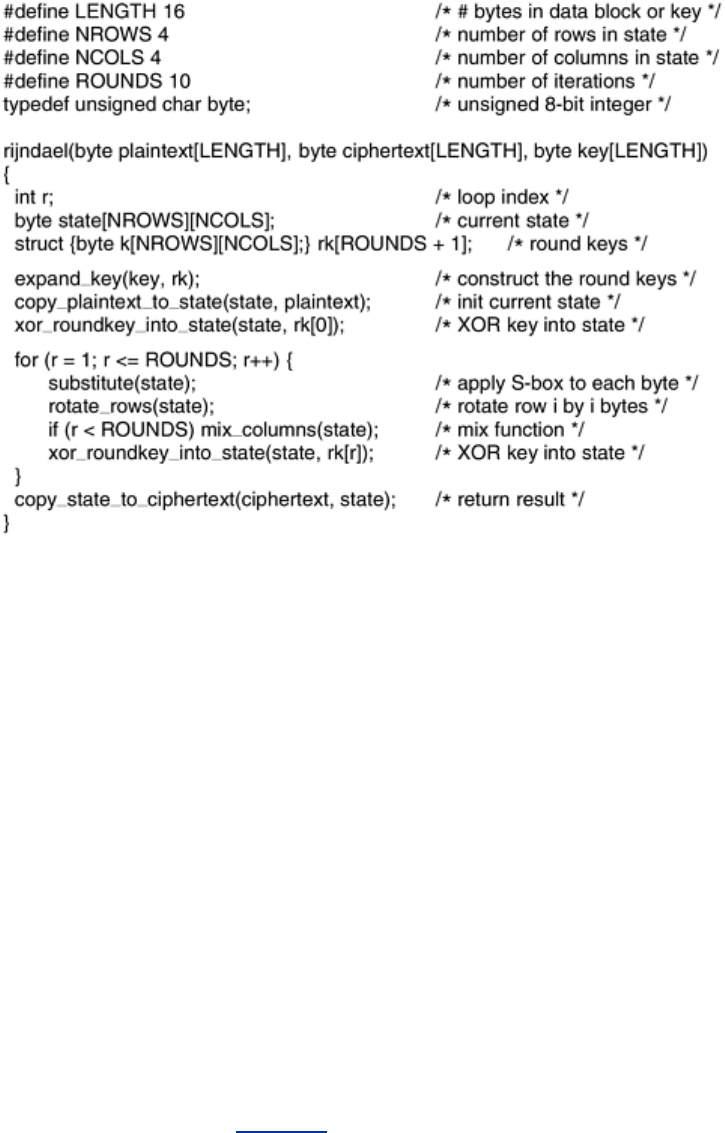
The function
rijndael has three parameters. They are: plaintext, an array of 16 bytes
containing the input data,
ciphertext, an array of 16 bytes where the enciphered output will be
returned, and
key, the 16-byte key. During the calculation, the current state of the data is
maintained in a byte array,
state, whose size is NROWS x NCOLS. For 128-bit blocks, this
array is 4 x 4 bytes. With 16 bytes, the full 128-bit data block can be stored.
The
state array is initialized to the plaintext and modified by every step in the computation. In
some steps, byte-for-byte substitution is performed. In others, the bytes are permuted within
the array. Other transformations are also used. At the end, the contents of the
state are
returned as the ciphertext.
The code starts out by expanding the key into 11 arrays of the same size as the state. They
are stored in
rk, which is an array of structs, each containing a state array. One of these will
be used at the start of the calculation and the other 10 will be used during the 10 rounds, one
per round. The calculation of the round keys from the encryption key is too complicated for us
to get into here. Suffice it to say that the round keys are produced by repeated rotation and
XORing of various groups of key bits. For all the details, see (Daemen and Rijmen, 2002).
The next step is to copy the plaintext into the
state array so it can be processed during the
rounds. It is copied in column order, with the first four bytes going into column 0, the next
four bytes going into column 1, and so on. Both the columns and the rows are numbered
starting at 0, although the rounds are numbered starting at 1. This initial setup of the 12 byte
arrays of size 4 x 4 is illustrated in
Fig. 8-10.
Figure 8-10. Creating of the state and rk arrays.
574
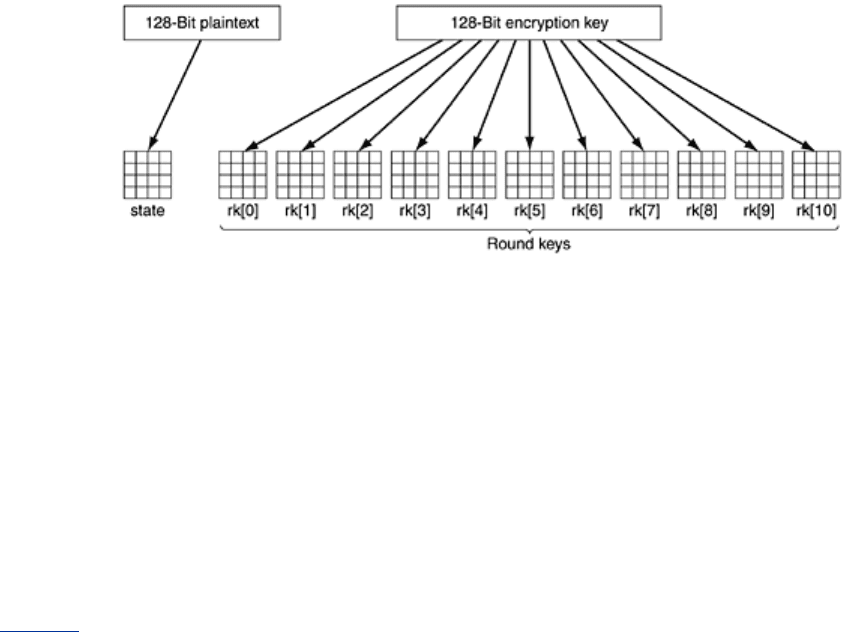
There is one more step before the main computation begins:
rk[0] is XORed into state byte for
byte. In other words each of the 16 bytes in
state is replaced by the XOR of itself and the
corresponding byte in
rk[0].
Now it is time for the main attraction. The loop executes 10 iterations, one per round,
transforming
state on each iteration. The contents of each round consist of four steps. Step 1
does a byte-for-byte substitution on
state. Each byte in turn is used as an index into an S-box
to replace its value by the contents of that S-box entry. This step is a straight monoalphabetic
substitution cipher. Unlike DES, which has multiple S-boxes, Rijndael has only one S-box.
Step 2 rotates each of the four rows to the left. Row 0 is rotated 0 bytes (i.e., not changed),
row 1 is rotated 1 byte, row 2 is rotated 2 bytes, and row 3 is rotated 3 bytes. This step
diffuses the contents of the current data around the block, analogous to the permutations of
Fig. 8-6.
Step 3 mixes up each column independently of the other ones. The mixing is done using
matrix multiplication in which the new column is the product of the old column and a constant
matrix, with the multiplication done using the finite Galois field,
GF(2
8
). Although this may
sound complicated, an algorithm exists that allows each element of the new column to be
computed using two table lookups and three XORs (Daemen and Rijmen, 2002, Appendix E).
Finally, step 4 XORs the key for this round into the
state array.
Since every step is reversible, decryption can be done just by running the algorithm backward.
However, there is also a trick available in which decryption can be done by running the
encryption algorithm, using different tables.
The algorithm has been designed not only for great security, but also for great speed. A good
software implementation on a 2-GHz machine should be able to achieve an encryption rate of
700 Mbps, which is fast enough to encrypt over 100 MPEG-2 videos in real time. Hardware
implementations are faster still.
8.2.3 Cipher Modes
Despite all this complexity, AES (or DES or any block cipher for that matter) is basically a
monoalphabetic substitution cipher using big characters (128-bit characters for AES and 64-bit
characters for DES). Whenever the same plaintext block goes in the front end, the same
ciphertext block comes out the back end. If you encrypt the plaintext
abcdefgh 100 times with
the same DES key, you get the same ciphertext 100 times. An intruder can exploit this
property to help subvert the cipher.
Electronic Code Book Mode
To see how this monoalphabetic substitution cipher property can be used to partially defeat the
cipher, we will use (triple) DES because it is easier to depict 64-bit blocks than 128-bit blocks,
575
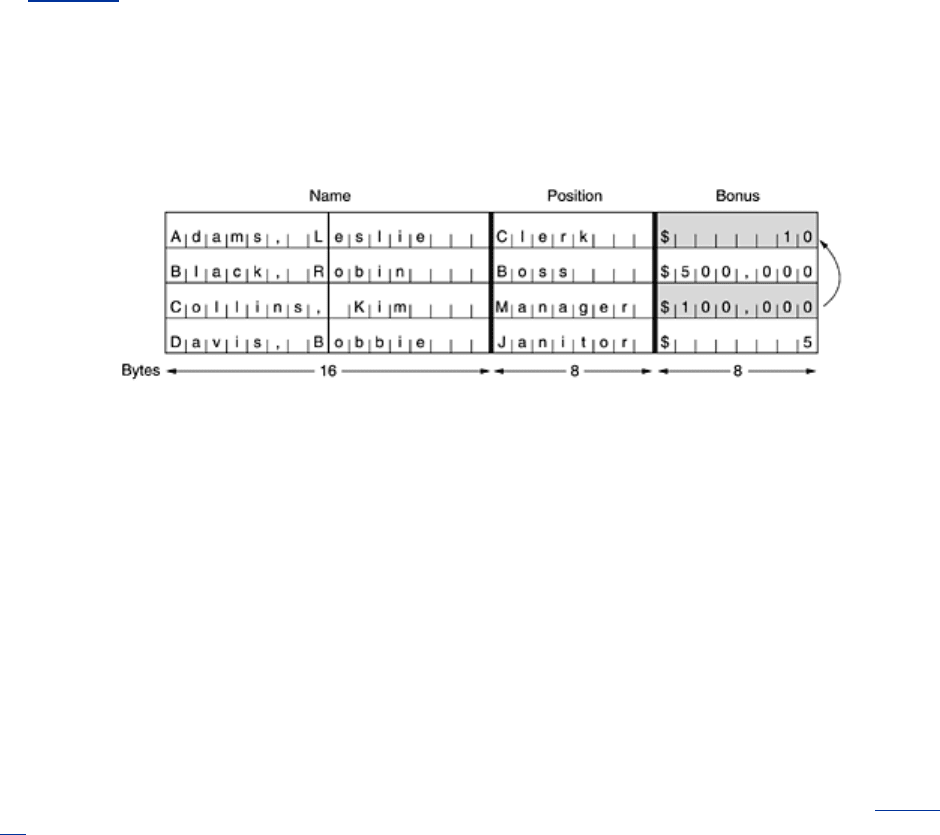
but AES has exactly the same problem. The straightforward way to use DES to encrypt a long
piece of plaintext is to break it up into consecutive 8-byte (64-bit) blocks and encrypt them
one after another with the same key. The last piece of plaintext is padded out to 64 bits, if
need be. This technique is known as
ECB mode (Electronic Code Book mode) in analogy
with old-fashioned code books where each plaintext word was listed, followed by its ciphertext
(usually a five-digit decimal number).
In
Fig. 8-11 we have the start of a computer file listing the annual bonuses a company has
decided to award to its employees. This file consists of consecutive 32-byte records, one per
employee, in the format shown: 16 bytes for the name, 8 bytes for the position, and 8 bytes
for the bonus. Each of the sixteen 8-byte blocks (numbered from 0 to 15) is encrypted by
(triple) DES.
Figure 8-11. The plaintext of a file encrypted as 16 DES blocks.
Leslie just had a fight with the boss and is not expecting much of a bonus. Kim, in contrast, is
the boss' favorite, and everyone knows this. Leslie can get access to the file after it is
encrypted but before it is sent to the bank. Can Leslie rectify this unfair situation, given only
the encrypted file?
No problem at all. All Leslie has to do is make a copy of the 12th ciphertext block (which
contains Kim's bonus) and use it to replace the 4th ciphertext block (which contains Leslie's
bonus). Even without knowing what the 12th block says, Leslie can expect to have a much
merrier Christmas this year. (Copying the 8th ciphertext block is also a possibility, but is more
likely to be detected; besides, Leslie is not a greedy person.)
Cipher Block Chaining Mode
To thwart this type of attack, all block ciphers can be chained in various ways so that replacing
a block the way Leslie did will cause the plaintext decrypted starting at the replaced block to
be garbage. One way of chaining is
cipher block chaining. In this method, shown in Fig. 8-
12, each plaintext block is XORed with the previous ciphertext block before being encrypted.
Consequently, the same plaintext block no longer maps onto the same ciphertext block, and
the encryption is no longer a big monoalphabetic substitution cipher. The first block is XORed
with a randomly chosen
IV (Initialization Vector), which is transmitted (in plaintext) along
with the ciphertext.
Figure 8-12. Cipher block chaining. (a) Encryption. (b) Decryption.
576
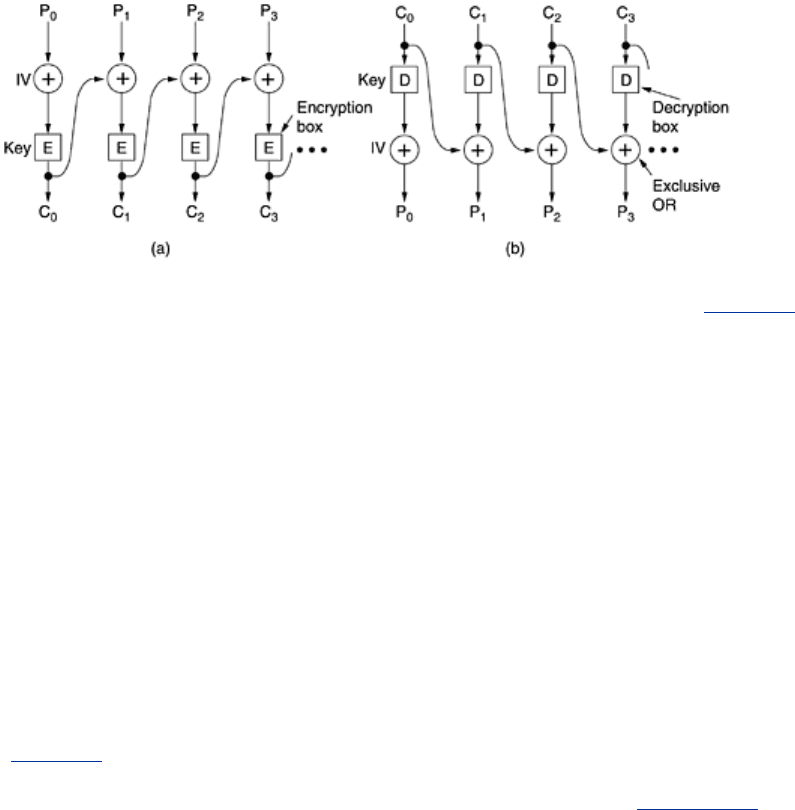
We can see how cipher block chaining mode works by examining the example of
Fig. 8-12. We
start out by computing
C
0
= E(P
0
XOR IV). Then we compute C
1
= E(P
1
XOR C
0
), and so on.
Decryption also uses XOR to reverse the process, with
P
0
= IV XOR D(C
0
), and so on. Note that
the encryption of block
i is a function of all the plaintext in blocks 0 through i - 1, so the same
plaintext generates different ciphertext depending on where it occurs. A transformation of the
type Leslie made will result in nonsense for two blocks starting at Leslie's bonus field. To an
astute security officer, this peculiarity might suggest where to start the ensuing investigation.
Cipher block chaining also has the advantage that the same plaintext block will not result in
the same ciphertext block, making cryptanalysis more difficult. In fact, this is the main reason
it is used.
Cipher Feedback Mode
However, cipher block chaining has the disadvantage of requiring an entire 64-bit block to
arrive before decryption can begin. For use with interactive terminals, where people can type
lines shorter than eight characters and then stop, waiting for a response, this mode is
unsuitable. For byte-by-byte encryption,
cipher feedback mode, using (triple) DES is used,
as shown in
Fig. 8-13. For AES the idea is exactly the same, only a 128-bit shift register is
used. In this figure, the state of the encryption machine is shown after bytes 0 through 9 have
been encrypted and sent. When plaintext byte 10 arrives, as illustrated in
Fig. 8-13(a), the
DES algorithm operates on the 64-bit shift register to generate a 64-bit ciphertext. The
leftmost byte of that ciphertext is extracted and XORed with
P
10
. That byte is transmitted on
the transmission line. In addition, the shift register is shifted left 8 bits, causing
C
2
to fall off
the left end, and
C
10
is inserted in the position just vacated at the right end by C
9
. Note that
the contents of the shift register depend on the entire previous history of the plaintext, so a
pattern that repeats multiple times in the plaintext will be encrypted differently each time in
the ciphertext. As with cipher block chaining, an initialization vector is needed to start the ball
rolling.
Figure 8-13. Cipher feedback mode. (a) Encryption. (b) Decryption.
577
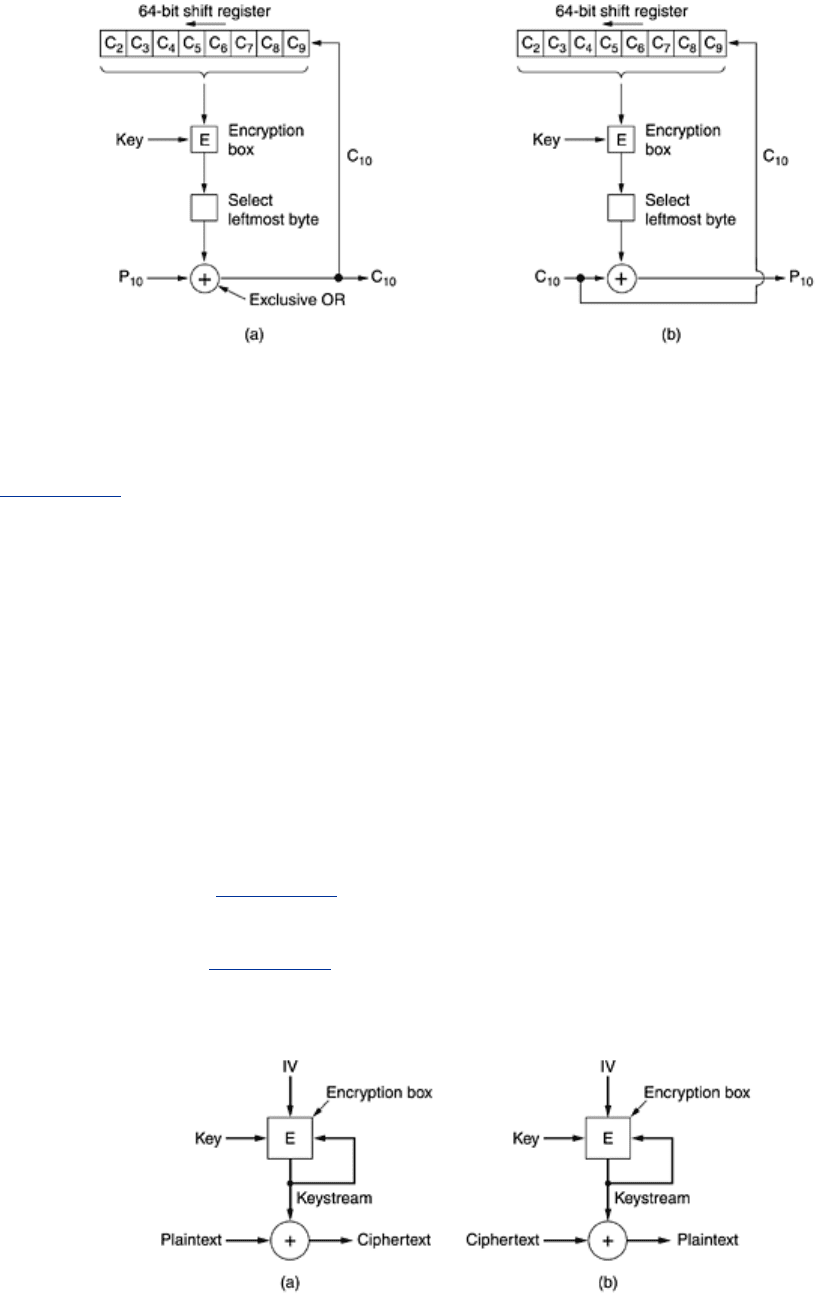
Decryption with cipher feedback mode just does the same thing as encryption. In particular,
the content of the shift register is
encrypted, not decrypted, so the selected byte that is XORed
with
C
10
to get P
10
is the same one that was XORed with P
10
to generate C
10
in the first place.
As long as the two shift registers remain identical, decryption works correctly. It is illustrated
in
Fig. 8-13(b).
A problem with cipher feedback mode is that if one bit of the ciphertext is accidentally inverted
during transmission, the 8 bytes that are decrypted while the bad byte is in the shift register
will be corrupted. Once the bad byte is pushed out of the shift register, correct plaintext will
once again be generated. Thus, the effects of a single inverted bit are relatively localized and
do not ruin the rest of the message, but they do ruin as many bits as the shift register is wide.
Stream Cipher Mode
Nevertheless, applications exist in which having a 1-bit transmission error mess up 64 bits of
plaintext is too large an effect. For these applications, a fourth option,
stream cipher mode,
exists. It works by encrypting an initialization vector, using a key to get an output block. The
output block is then encrypted, using the key to get a second output block. This block is then
encrypted to get a third block, and so on. The (arbitrarily large) sequence of output blocks,
called the
keystream, is treated like a one-time pad and XORed with the plaintext to get the
ciphertext, as shown in
Fig. 8-14(a). Note that the IV is used only on the first step. After that,
the output is encrypted. Also note that the keystream is independent of the data, so it can be
computed in advance, if need be, and is completely insensitive to transmission errors.
Decryption is shown in
Fig. 8-14(b).
Figure 8-14. A stream cipher. (a) Encryption. (b) Decryption.
Decryption occurs by generating the same keystream at the receiving side. Since the
keystream depends only on the IV and the key, it is not affected by transmission errors in the
ciphertext. Thus, a 1-bit error in the transmitted ciphertext generates only a 1-bit error in the
decrypted plaintext.
578
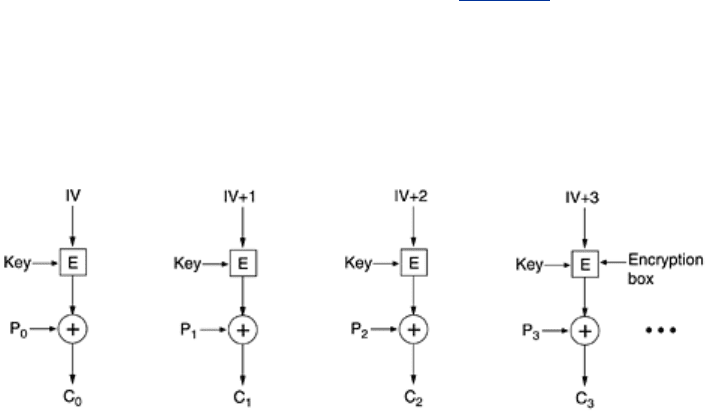
It is essential never to use the same (key, IV) pair twice with a stream cipher because doing
so will generate the same keystream each time. Using the same keystream twice exposes the
ciphertext to a
keystream reuse attack. Imagine that the plaintext block, P
0
, is encrypted
with the keystream to get
P
0
XOR K
0
. Later, a second plaintext block, Q
0
, is encrypted with the
same keystream to get
Q
0
XOR K
0
. An intruder who captures both of these ciphertext blocks
can simply XOR them together to get
P
0
XOR Q
0
, which eliminates the key. The intruder now
has the XOR of the two plaintext blocks. If one of them is known or can be guessed, the other
can also be found. In any event, the XOR of two plaintext streams can be attacked by using
statistical properties of the message. For example, for English text, the most common
character in the stream will probably be the XOR of two spaces, followed by the XOR of space
and the letter ''e'', etc. In short, equipped with the XOR of two plaintexts, the cryptanalyst has
an excellent chance of deducing both of them.
Counter Mode
One problem that all the modes except electronic code book mode have is that random access
to encrypted data is impossible. For example, suppose a file is transmitted over a network and
then stored on disk in encrypted form. This might be a reasonable way to operate if the
receiving computer is a notebook computer that might be stolen. Storing all critical files in
encrypted form greatly reduces the damage due to secret information leaking out in the event
that the computer falls into the wrong hands.
However, disk files are often accessed in nonsequential order, especially files in databases.
With a file encrypted using cipher block chaining, accessing a random block requires first
decrypting all the blocks ahead of it, an expensive proposition. For this reason, yet another
mode has been invented,
counter mode,as illustrated in Fig. 8-15. Here the plaintext is not
encrypted directly. Instead, the initialization vector plus a constant is encrypted, and the
resulting ciphertext XORed with the plaintext. By stepping the initialization vector by 1 for each
new block, it is easy to decrypt a block anywhere in the file without first having to decrypt all
of its predecessors.
Figure 8-15. Encryption using counter mode.
Although counter mode is useful, it has a weakness that is worth pointing out. Suppose that
the same key,
K, is used again in the future (with a different plaintext but the same IV) and an
attacker acquires all the ciphertext from both runs. The keystreams are the same in both
cases, exposing the cipher to a keystream reuse attack of the same kind we saw with stream
ciphers. All the cryptanalyst has to do is to XOR the two ciphertexts together to eliminate all
the cryptographic protection and just get the XOR of the plaintexts. This weakness does not
mean counter mode is a bad idea. It just means that both keys and initialization vectors should
be chosen independently and at random. Even if the same key is accidentally used twice, if the
IV is different each time, the plaintext is safe.
579

8.2.4 Other Ciphers
DES and Rijndael are the best-known symmetric-key, cryptographic algorithms. However, it is
worth mentioning that numerous other symmetric-key ciphers have been devised. Some of
these are embedded inside various products. A few of the more common ones are listed in
Fig.
8-16.
Figure 8-16. Some common symmetric-key cryptographic algorithms.
8.2.5 Cryptanalysis
Before leaving the subject of symmetric-key cryptography, it is worth at least mentioning four
developments in cryptanalysis. The first development is
differential cryptanalysis (Biham
and Shamir, 1993). This technique can be used to attack any block cipher. It works by
beginning with a pair of plaintext blocks that differ in only a small number of bits and watching
carefully what happens on each internal iteration as the encryption proceeds. In many cases,
some bit patterns are much more common than other patterns, and this observation leads to a
probabilistic attack.
The second development worth noting is
linear cryptanalysis (Matsui, 1994). It can break
DES with only 2
43
known plaintexts. It works by XORing certain bits in the plaintext and
ciphertext together and examining the result for patterns. When this is done repeatedly, half
the bits should be 0s and half should be 1s. Often, however, ciphers introduce a bias in one
direction or the other, and this bias, however small, can be exploited to reduce the work
factor. For the details, see Matsui's paper.
The third development is using analysis of the electrical power consumption to find secret
keys. Computers typically use 3 volts to represent a 1 bit and 0 volts to represent a 0 bit.
Thus, processing a 1 takes more electrical energy than processing a 0. If a cryptographic
algorithm consists of a loop in which the key bits are processed in order, an attacker who
replaces the main
n-GHz clock with a slow (e.g., 100-Hz) clock and puts alligator clips on the
CPU's power and ground pins, can precisely monitor the power consumed by each machine
instruction. From this data, deducing the key is surprisingly easy. This kind of cryptanalysis
can be defeated only by carefully coding the algorithm in assembly language to make sure
power consumption is independent of the key and also independent of all the individual round
keys.
The fourth development is timing analysis. Cryptographic algorithms are full of
if statements
that test bits in the round keys. If the
then and else parts take different amounts of time, by
slowing down the clock and seeing how long various steps take, it may also be possible to
deduce the round keys. Once all the round keys are known, the original key can usually be
computed. Power and timing analysis can also be employed simultaneously to make the job
580
